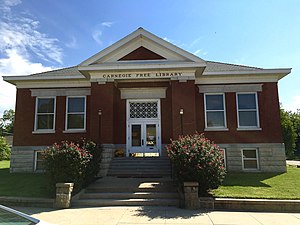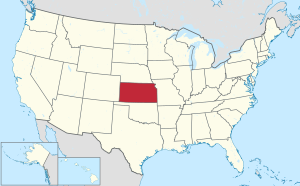Coffey County | |
|---|---|
 | |
 Location within the U.S. state of Kansas | |
 Kansas's location within the U.S. | |
| Coordinates: 38°14′N 95°44′W / 38.233°N 95.733°W | |
| Country | |
| State | |
| Founded | August 25, 1855 |
| Named for | Asbury M. Coffey |
| Seat | Burlington |
| Largest city | Burlington |
| Area | |
• Total | 654 sq mi (1,690 km2) |
| • Land | 627 sq mi (1,620 km2) |
| • Water | 27 sq mi (70 km2) 4.2% |
| Population | |
• Total | 8,360 |
• Estimate (2023)[2] | 8,251 |
| • Density | 13.3/sq mi (5.1/km2) |
| Time zone | UTC−6 (Central) |
| • Summer (DST) | UTC−5 (CDT) |
| Area code | 620 |
| Congressional district | 2nd |
| Website | CoffeyCountyKS.org |
Coffey County is a county located in Eastern Kansas. Its county seat and most populous city is Burlington.[3] As of the 2020 census, the county population was 8,360.[1] It was named after A.M. Coffey, a territorial legislator and Free-Stater during Bleeding Kansas era.
History
[edit]Early history
[edit]For many millennia, the Great Plains of North America was inhabited by nomadic Native Americans. From the 16th century to 18th century, the Kingdom of France claimed ownership of large parts of North America. In 1762, after the French and Indian War, France secretly ceded New France to Spain, per the Treaty of Fontainebleau.
19th century
[edit]In 1802, Spain returned most of the land to France, but keeping title to about 7,500 square miles. In 1803, most of the land for modern day Kansas was acquired by the United States from France as part of the 828,000 square mile Louisiana Purchase for 2.83 cents per acre.
In 1854, the Kansas Territory was organized, then in 1861 Kansas became the 34th U.S. state. In 1855, Coffey County was established.
Geography
[edit]According to the U.S. Census Bureau, the county has a total area of 654 square miles (1,690 km2), of which 627 square miles (1,620 km2) is land and 27 square miles (70 km2) (4.2%) is water.[4]
Adjacent counties
[edit]- Osage County (north)
- Franklin County (northeast)
- Anderson County (east)
- Allen County (southeast)
- Woodson County (south)
- Greenwood County (southwest)
- Lyon County (northwest)
Major highways
[edit]Sources: National Atlas,[5] U.S. Census Bureau[6]
National protected area
[edit]Demographics
[edit]
| Census | Pop. | Note | %± |
|---|---|---|---|
| 1860 | 2,842 | — | |
| 1870 | 6,201 | 118.2% | |
| 1880 | 11,438 | 84.5% | |
| 1890 | 15,856 | 38.6% | |
| 1900 | 16,643 | 5.0% | |
| 1910 | 15,205 | −8.6% | |
| 1920 | 14,254 | −6.3% | |
| 1930 | 13,653 | −4.2% | |
| 1940 | 12,278 | −10.1% | |
| 1950 | 10,408 | −15.2% | |
| 1960 | 8,403 | −19.3% | |
| 1970 | 7,397 | −12.0% | |
| 1980 | 9,370 | 26.7% | |
| 1990 | 8,404 | −10.3% | |
| 2000 | 8,865 | 5.5% | |
| 2010 | 8,601 | −3.0% | |
| 2020 | 8,360 | −2.8% | |
| 2023 (est.) | 8,251 | [2] | −1.3% |
| U.S. Decennial Census[7] 1790-1960[8] 1900-1990[9] 1990-2000[10] 2010-2020[1] | |||
As of the 2000 census,[11] there were 8,865 people, 3,489 households, and 2,477 families residing in the county. The population density was 14 people per square mile (5.4 people/km2). There were 3,876 housing units at an average density of 6 per square mile (2.3/km2). The racial makeup of the county was 96.95% White, 0.25% Black or African American, 0.52% Native American, 0.34% Asian, 0.01% Pacific Islander, 0.50% from other races, and 1.43% from two or more races. Hispanic or Latino of any race were 1.55% of the population.
There were 3,489 households, out of which 33.20% had children under the age of 18 living with them, 60.70% were married couples living together, 6.90% had a female householder with no husband present, and 29.00% were non-families. 26.00% of all households were made up of individuals, and 12.60% had someone living alone who was 65 years of age or older. The average household size was 2.49 and the average family size was 2.99.
In the county, the population was spread out, with 26.80% under the age of 18, 6.50% from 18 to 24, 26.40% from 25 to 44, 24.00% from 45 to 64, and 16.20% who were 65 years of age or older. The median age was 39 years. For every 100 females there were 96.20 males. For every 100 females age 18 and over, there were 92.50 males.
The median income for a household in the county was $37,839, and the median income for a family was $44,912. Males had a median income of $31,356 versus $20,666 for females. The per capita income for the county was $18,337. About 5.00% of families and 6.60% of the population were below the poverty line, including 5.00% of those under age 18 and 9.80% of those age 65 or over.
Government
[edit]Presidential elections
[edit]| Year | Republican | Democratic | Third party(ies) | |||
|---|---|---|---|---|---|---|
| No. | % | No. | % | No. | % | |
| 2024 | 3,371 | 76.68% | 934 | 21.25% | 91 | 2.07% |
| 2020 | 3,489 | 76.43% | 964 | 21.12% | 112 | 2.45% |
| 2016 | 3,050 | 74.98% | 727 | 17.87% | 291 | 7.15% |
| 2012 | 2,903 | 74.32% | 898 | 22.99% | 105 | 2.69% |
| 2008 | 3,054 | 72.16% | 1,121 | 26.49% | 57 | 1.35% |
| 2004 | 3,259 | 73.93% | 1,093 | 24.80% | 56 | 1.27% |
| 2000 | 2,700 | 66.83% | 1,196 | 29.60% | 144 | 3.56% |
| 1996 | 2,369 | 57.92% | 1,118 | 27.33% | 603 | 14.74% |
| 1992 | 1,824 | 42.44% | 1,021 | 23.76% | 1,453 | 33.81% |
| 1988 | 2,581 | 66.69% | 1,246 | 32.20% | 43 | 1.11% |
| 1984 | 3,063 | 74.00% | 1,037 | 25.05% | 39 | 0.94% |
| 1980 | 2,491 | 69.16% | 938 | 26.04% | 173 | 4.80% |
| 1976 | 2,145 | 56.70% | 1,549 | 40.95% | 89 | 2.35% |
| 1972 | 2,667 | 75.70% | 782 | 22.20% | 74 | 2.10% |
| 1968 | 2,223 | 63.06% | 933 | 26.47% | 369 | 10.47% |
| 1964 | 1,998 | 55.41% | 1,594 | 44.20% | 14 | 0.39% |
| 1960 | 2,925 | 69.69% | 1,263 | 30.09% | 9 | 0.21% |
| 1956 | 3,286 | 72.24% | 1,247 | 27.41% | 16 | 0.35% |
| 1952 | 3,731 | 74.78% | 1,239 | 24.83% | 19 | 0.38% |
| 1948 | 2,945 | 61.20% | 1,796 | 37.32% | 71 | 1.48% |
| 1944 | 3,461 | 67.28% | 1,660 | 32.27% | 23 | 0.45% |
| 1940 | 4,164 | 64.26% | 2,272 | 35.06% | 44 | 0.68% |
| 1936 | 3,900 | 59.29% | 2,662 | 40.47% | 16 | 0.24% |
| 1932 | 2,707 | 43.77% | 3,389 | 54.80% | 88 | 1.42% |
| 1928 | 4,342 | 73.81% | 1,514 | 25.74% | 27 | 0.46% |
| 1924 | 3,552 | 62.47% | 1,631 | 28.68% | 503 | 8.85% |
| 1920 | 3,370 | 64.20% | 1,785 | 34.01% | 94 | 1.79% |
| 1916 | 2,799 | 45.57% | 3,121 | 50.81% | 222 | 3.61% |
| 1912 | 681 | 18.73% | 1,581 | 43.48% | 1,374 | 37.79% |
| 1908 | 2,094 | 53.38% | 1,729 | 44.07% | 100 | 2.55% |
| 1904 | 2,164 | 59.39% | 1,280 | 35.13% | 200 | 5.49% |
| 1900 | 2,159 | 50.46% | 2,066 | 48.28% | 54 | 1.26% |
| 1896 | 2,000 | 46.84% | 2,194 | 51.38% | 76 | 1.78% |
| 1892 | 1,769 | 47.53% | 0 | 0.00% | 1,953 | 52.47% |
| 1888 | 1,970 | 52.59% | 1,227 | 32.75% | 549 | 14.66% |
Laws
[edit]Following amendment to the Kansas Constitution in 1986, Coffey County remained a prohibition, or "dry", county until 2004, when voters approved the sale of alcoholic liquor by the individual drink with a 30 percent food sales requirement.[13]
Education
[edit]Unified school districts
[edit]They include:[14]
- Lebo–Waverly USD 243
- Burlington USD 244
- LeRoy–Gridley USD 245 (Southern Coffey County)
- School district office in neighboring county[14]
Communities
[edit]
List of townships / incorporated cities / unincorporated communities / extinct former communities within Coffey County.[15]
Cities
[edit]- Burlington (county seat)
- Gridley
- Lebo
- LeRoy
- New Strawn
- Waverly
Unincorporated communities
[edit]Townships
[edit]Coffey County is divided into fourteen townships. The city of Burlington is considered governmentally independent and is excluded from the census figures for the townships. In the following table, the population center is the largest city (or cities) included in that township's population total, if it is of a significant size.
Notable people
[edit]- Alan L. Hart (1890–1962), transgender physician, radiologist, tuberculosis researcher, writer, and novelist
See also
[edit]- Community information for Kansas
- Kansas locations by per capita income
- List of counties in Kansas
- List of townships in Kansas
- List of cities in Kansas
- List of unincorporated communities in Kansas
- List of ghost towns in Kansas
References
[edit]- ^ a b c "QuickFacts; Coffey County, Kansas; Population, Census, 2020 & 2010". United States Census Bureau. Archived from the original on August 16, 2021. Retrieved August 15, 2021.
- ^ a b "Annual Estimates of the Resident Population for Counties: April 1, 2020 to July 1, 2023". United States Census Bureau. Retrieved March 24, 2024.
- ^ "Find a County". National Association of Counties. Archived from the original on May 31, 2011. Retrieved June 7, 2011.
- ^ "US Gazetteer files: 2010, 2000, and 1990". United States Census Bureau. February 12, 2011. Retrieved April 23, 2011.
- ^ National Atlas Archived December 5, 2008, at the Wayback Machine
- ^ U.S. Census Bureau TIGER shape files
- ^ "U.S. Decennial Census". United States Census Bureau. Retrieved July 22, 2014.
- ^ "Historical Census Browser". University of Virginia Library. Archived from the original on August 11, 2012. Retrieved July 22, 2014.
- ^ "Population of Counties by Decennial Census: 1900 to 1990". United States Census Bureau. Retrieved July 22, 2014.
- ^ "Census 2000 PHC-T-4. Ranking Tables for Counties: 1990 and 2000" (PDF). United States Census Bureau. Archived (PDF) from the original on March 27, 2010. Retrieved July 22, 2014.
- ^ "U.S. Census website". United States Census Bureau. Retrieved January 31, 2008.
- ^ "Dave Leip's Atlas of U.S. Presidential Elections".
- ^ "Map of Wet and Dry Counties". Alcoholic Beverage Control, Kansas Department of Revenue. November 2006. Archived from the original on October 8, 2007. Retrieved December 26, 2007.
- ^ a b "2020 CENSUS - SCHOOL DISTRICT REFERENCE MAP: Coffey County, KS" (PDF). U.S. Census Bureau. Retrieved November 10, 2024. - Text list
- ^ a b "General Highway Map of Coffey County, Kansas" (PDF). Kansas Department of Transportation (KDOT). November 2008. Archived (PDF) from the original on June 9, 2023.
Further reading
[edit]- Standard Atlas of Coffey County, Kansas; Geo. A. Ogle & Co; 69 pages; 1919.
- Plat Book of Coffey County, Kansas; North West Publishing Co; 40 pages; 1901.
- An Illustrated Historical Atlas of Coffey County, Kansas; Edwards Brothers; 44 pages; 1878.
External links
[edit]- County
- Maps
